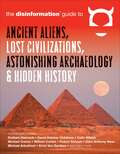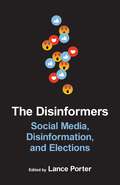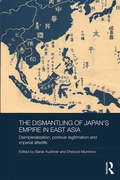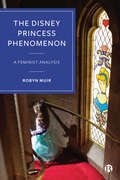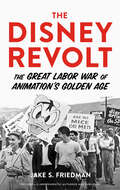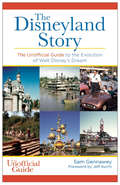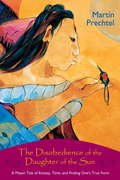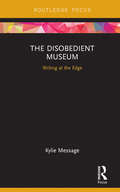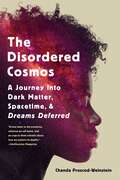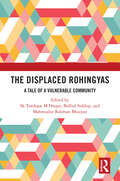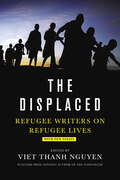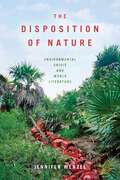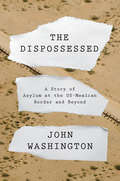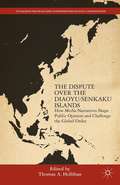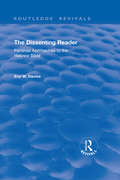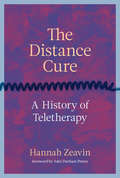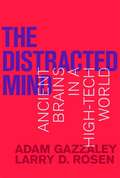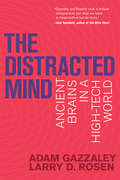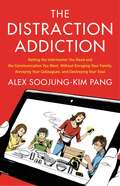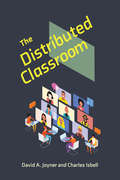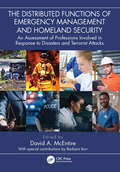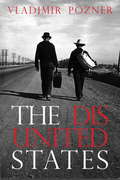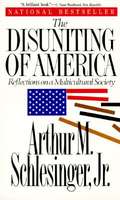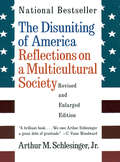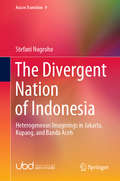- Table View
- List View
The Disinformation Guide to Ancient Aliens, Lost Civilizations, Astonishing Archaeology & Hidden History (Disinformation Guides)
by The Disinformation GuideThis compendium of ancient mysteries and controversial knowledge is “an excellent briefing on the genre and its complexities” (Fortean Times).Where did “modern” civilization begin? What lies beneath the waves? Do myths describe interstellar impact? How’d they lift that stone? Was the Ark of the Covenant a mechanical device? Were there survivors of an Atlantean catastrophe? Who really discovered the “New” World? “Hidden history” continues to fascinate an ever wider audience. In this massive compendium, editor Preston Peet brings together an all-star cast of contributors to question established wisdom about the history of the world and its civilizations. Peet and anthology contributors guide us through exciting archeological adventures and treasure hunts, ancient mysteries, lost or rediscovered technologies, and assorted “Forteana,” using serious scientific studies and reports, scholarly research, and some plain old fringe material, as what is considered “fringe” today is often hard science tomorrow. Contributors include: Graham Hancock (Fingerprints of the Gods and Underworld), David Hatcher Childress (Lost Cities and Civilizations series), Colin Wilson (From Atlantis to the Sphinx), Michael Cremo (Forbidden Archeology), William Corliss (Ancient Infrastructures), Robert Schoch (Voyages of the Pyramid Builders), John Anthony West (Serpent in the Sky), Michael Arbuthnot (Team Atlantis), Erich Von Daniken (Chariots of the Gods), and many more.
The Disinformers: Social Media, Disinformation, and Elections (Media and Public Affairs)
by Robert Mann Dr Claudia Flores-Saviaga Dr Jacob Groshek Dr Itai Himelboim Dr David Karpf Dr Yotam Ophir Dr Josephine Lukito Dr Jakob Ohme Dr Golden Richard III Dr Saiph Savage Sander Andreas Schwarz Dr Dror WalterThe Disinformers uncovers the people and the organizations behind the disinformation campaigns that began on social media with the 2016 U.S. presidential election and reached a violent crescendo with the storming of the U.S. Capitol on January 6, 2021. Edited by social media researcher Lance Porter, this vital collection of interdisciplinary scholarship analyzes how foreign interference destabilized political conversations, stoked racial tensions, and spread disinformation across social media platforms to produce increasing friction among voters. With a new presidential election cycle in motion, members of the voting public continue questioning both the security of the nation’s election systems and the validity of its media networks. The 2016 election thrust the vulnerability of voting technology to the forefront of conversations in the United States and sparked discussions about the use of social media to distribute divisive and false information. While Donald Trump’s claims of fraud in the 2016 and 2020 elections were verifiably false, disinformation undoubtedly roiled the nation’s media systems and spurred on the insurrection of January 6. Presenting seven essays of original research, The Disinformers focuses on the turning point of 2016 and how disinformation campaigns continued in the following years. The contributors examine organizations such as Russia’s Internet Research Agency and its connections with a conservative network across social media, including Facebook and Twitter, that disseminated incendiary content. Essays from political scientists, media scholars, computer scientists, and cybersecurity experts reveal the ways in which disinformation permeates social media, the platform policies and chronic inaction that enable disinformation to circulate, and the effects of disinformation on young people as well as on historically repressed groups. At a critical time in the U.S. political cycle, The Disinformers provides in-depth analysis of issues essential to understanding the role disinformation can play in elections across the world.
The Dismantling of Japan's Empire in East Asia: Deimperialization, Postwar Legitimation and Imperial Afterlife (Routledge Studies in the Modern History of Asia)
by Barak Kushner Sherzod MuminovThe end of Japan’s empire appeared to happen very suddenly and cleanly – but, as this book shows, it was in fact very messy, with a long period of establishing or re-establishing the postwar order. Moreover, as the authors argue, empires have afterlives, which, in the case of Japan’s empire, is not much studied. This book considers the details of deimperialization, including the repatriation of Japanese personnel, the redrawing of boundaries, issues to do with prisoners of war and war criminals and new arrangements for democratic political institutions, for media and for the regulation of trade. It also discusses the continuing impact of empire on the countries ruled or occupied by Japan, where, as a result of Japanese management and administration, both formal and informal, patterns of behavior and attitudes were established that continued subsequently. This was true in Japan itself, where returning imperial personnel had to be absorbed and adjustments made to imperial thinking, and in present-day East Asia, where the shadow of Japan’s empire still lingers. This legacy of unresolved issues concerning the correct relationship of Japan, an important, energetic, outgoing nation and a potential regional "hub," with the rest of the region not comfortably settled in this era, remains a fulcrum of regional dispute.
The Disney Princess Phenomenon: A Feminist Analysis
by Robyn MuirThe Disney Princesses are a billion-dollar industry, known and loved by children across the globe. Robyn Muir provides an exploratory and holistic examination of this worldwide commercial and cultural phenomenon in its key representations: films, merchandising and marketing, and park experiences. Muir highlights the messages and images of femininity found within the Disney Princess canon and provides a rigorous and innovative methodology for analysing gender in media. Including an in-depth examination of each princess film from the last 83 years, the book provides a lens through which to view and understand how Disney Princesses have contributed to the depiction of femininity within popular culture.
The Disney Revolt: The Great Labor War of Animation's Golden Age
by Jake S. FriedmanAn essential piece of Disney history has been largely unreported for eighty years. Soon after the birth of Mickey Mouse, one animator raised the Disney Studio far beyond Walt's expectations. That animator also led a union war that almost destroyed it. Art Babbitt animated for the Disney studio throughout the 1930s and through 1941, years in which he and Walt were jointly driven to elevate animation as an art form, up through Snow White, Pinocchio, and Fantasia. But as America prepared for World War II, labor unions spread across Hollywood. Disney fought the unions while Babbitt embraced them. Soon, angry Disney cartoon characters graced picket signs as hundreds of animation artists went out on strike. Adding fuel to the fire was Willie Bioff, one of Al Capone's wiseguys who was seizing control of Hollywood workers and vied for the animators' union. Using never-before-seen research from previously lost records, including conversation transcriptions from within the studio walls, author and historian Jake S. Friedman reveals the details behind the labor dispute that changed animation and Hollywood forever. The Disney Revolt is an American story of industry and of the underdog, the golden age of animated cartoons at the world's most famous studio.
The Disneyland Story
by Jeff Kurtti Sam GennaweyThe Disneyland Story: The Unofficial Guide to the Evolution of Walt Disney's Dream is the story of how Walt Disney's greatest creation was conceived, nurtured, and how it grew into a source of joy and inspiration for generations of visitors. Despite his successors' battles with the whims of history and their own doubts and egos, Walt's vision maintained momentum, thrived, and taught future generations how to do it Walt Disney's way.
The Disobedience of the Daughter of the Sun: A Mayan Tale of Ecstasy, Time, and Finding One's True Form
by Martin PrechtelAuthor and illustrator Martín Prechtel is internationally known for his explorations of ancient folklore and uncovering the lessons therein for modern readers. In The Disobedience of the Daughter of the Sun, he revives a hitherto unknown Guatemalan Tzutujil Mayan tale of the beginnings of the world with a poetic retelling of the story, 28 evocative drawings, and a critical analysis that both enlightens and entertains. Having lived with the Mayans and learned their language, Prechtel authoritatively retells the powerful tale of the Tall Girl who weaves the world in a loom, her parents the Sun and the Moon who repudiate her suitors, and the mysterious man who disguises himself as a hummingbird to lure her away. Prechtel expands this archetypal story with five layers of commentary, each teasing out a different wisdom and revealing its relevance to the world today.
The Disobedient Museum: Writing at the Edge (Museums in Focus)
by Kylie MessageThe Disobedient Museum: Writing at the Edge aims to motivate disciplinary thinking to reimagine writing about museums as an activity where resistant forms of thinking, seeing, feeling, and acting can be produced, and to theorize this process as a form of protest against disciplinary stagnation.Drawing on a range of cultural, theoretical, and political approaches, Kylie Message examines potential links between methods of critique today and moments of historical and disciplinary crisis, and asks what contribution museums might make to these, either as direct actors or through activities that sit more comfortably within their institutional remit. Identifying the process of writing about museums as a form of activism, that brings together and elaborates on cultural and political agendas for change, the book explores how a process of engaged critique might benefit museum studies, what this critique might look like, and how museum studies might make a contribution to discourses of social and political change.The Disobedient Museum is the first volume in Routledge’s innovative ‘Museums in Focus’ series and will be of great interest to scholars and students in the fields of Museum, Heritage, Public History, and Cultural Studies. It should also be essential reading for museum practitioners, particularly those engaged with questions about the role of museums in regard to social activism and contentious contemporary challenges.
The Disordered Cosmos: A Journey into Dark Matter, Spacetime, and Dreams Deferred
by Chanda Prescod-WeinsteinFrom a star theoretical physicist, a journey into the world of particle physics and the cosmos -- and a call for a more just practice of science. In The Disordered Cosmos, Dr. Chanda Prescod-Weinstein shares her love for physics, from the Standard Model of Particle Physics and what lies beyond it, to the physics of melanin in skin, to the latest theories of dark matter -- all with a new spin informed by history, politics, and the wisdom of Star Trek. One of the leading physicists of her generation, Dr. Chanda Prescod-Weinstein is also one of fewer than one hundred Black American women to earn a PhD from a department of physics. Her vision of the cosmos is vibrant, buoyantly non-traditional, and grounded in Black feminist traditions. Prescod-Weinstein urges us to recognize how science, like most fields, is rife with racism, sexism, and other dehumanizing systems. She lays out a bold new approach to science and society that begins with the belief that we all have a fundamental right to know and love the night sky. The Disordered Cosmos dreams into existence a world that allows everyone to experience and understand the wonders of the universe.
The Displaced Rohingyas: A Tale of a Vulnerable Community
by Sk Tawfique M Haque, Bulbul Siddiqi, and Mahmudur Rahman BhuiyanThis volume offers a comprehensive overview of the Rohingya refugee crisis in Bangladesh. It analyses the socio-cultural and humanitarian challenges of the crisis, along with the discourses that have developed on this issue via the local and international media and literature. The volume also suggests ways to build sustainable solutions for the Rohingya refugees. It discusses wide-ranging issues including a historical overview of the Rohingyas; the Rakhine State of Myanmar and the issue of religious toleration; the struggle for existence in Malaysia and Thailand; vulnerable Rohingya in Bangladesh; and stratified lives in Bangladeshi camps. It also sheds light on social insecurity among Rohingya adolescent girls; understanding gender-based violence in camps; the portrayal of the crisis in Chinese and Indian newspapers; and Bangladesh’s policy in addressing the Rohingya crisis and repatriation. This book will be useful for scholars and researchers of sociology, social anthropology, refugee studies, peace and conflict studies, international relations, human rights, political studies, gender studies, and South Asian studies.
The Displaced: Refugee Writers on Refugee Lives
by Viet Thanh Nguyen“Powerful and deeply moving personal stories about the physical and emotional toll one endures when forced out of one’s homeland.” —PBS OnlineIn January 2017, Donald Trump signed an executive order stopping entry to the United States from seven predominantly Muslim countries and dramatically cutting the number of refugees allowed to resettle in the United States each year. The American people spoke up, with protests, marches, donations, and lawsuits that quickly overturned the order. Though the refugee caps have been raised under President Biden, admissions so far have fallen short. In The Displaced, Pulitzer Prize–winning writer Viet Thanh Nguyen, himself a refugee, brings together a host of prominent refugee writers to explore and illuminate the refugee experience. Featuring original essays by a collection of writers from around the world, The Displaced is an indictment of closing our doors, and a powerful look at what it means to be forced to leave home and find a place of refuge.“One of the Ten Best Books of the Year.” —Minneapolis Star-Tribune“Together, the stories share similar threads of loss and adjustment, of the confusion of identity, of wounds that heal and those that don’t, of the scars that remain.” —San Francisco Chronicle“Poignant and timely, these essays ask us to live with our eyes wide open during a time of geo-political crisis. Also, 10% of the cover price of the book will be donated annually to the International Rescue Committee, so I hope readers will help support this book and the vast range of voices that fill its pages.” —Electric Literature
The Disposition of Nature: Environmental Crisis and World Literature
by Jennifer WenzelFinalist, 2022 Ecocriticism Book Prize, Association for the Study of Literature and the EnvironmentShortlisted, 2020 Book Prize, Association for the Study of the Arts of the PresentHow do literature and other cultural forms shape how we imagine the planet, for better or worse? In this rich, original, and long awaited book, Jennifer Wenzel tackles the formal innovations, rhetorical appeals, and sociological imbrications of world literature that might help us confront unevenly distributed environmental crises, including global warming.The Disposition of Nature argues that assumptions about what nature is are at stake in conflicts over how it is inhabited or used. Both environmental discourse and world literature scholarship tend to confuse parts and wholes. Working with writing and film from Africa, South Asia, and beyond, Wenzel takes a contrapuntal approach to sites and subjects dispersed across space and time. Reading for the planet, Wenzel shows, means reading from near to there: across experiential divides, between specific sites, at more than one scale.Impressive in its disciplinary breadth, Wenzel’s book fuses insights from political ecology, geography, anthropology, history, and law, while drawing on active debates between postcolonial theory and world literature, as well as scholarship on the Anthropocene and the material turn. In doing so, the book shows the importance of the literary to environmental thought and practice, elaborating how a supple understanding of cultural imagination and narrative logics can foster more robust accounts of global inequality and energize movements for justice and livable futures.
The Dispossessed: A Story of Asylum and the US-Mexican Border and Beyond
by John WashingtonThe first comprehensive, in-depth book on the Trump administration&’s assault on asylum protectionsArnovis couldn&’t stay in El Salvador. If he didn&’t leave, a local gangster promised that his family would dress in mourning—that he would wake up with flies in his mouth. &“It was like a bomb exploded in my life,&” Arnovis said. The Dispossessed tells the story of a twenty-four-year-old Salvadoran man, Arnovis, whose family&’s search for safety shows how the United States—in concert with other Western nations—has gutted asylum protections for the world&’s most vulnerable. Crisscrossing the border and Central America, John Washington traces one man&’s quest for asylum. Arnovis is separated from his daughter by US Border Patrol agents and struggles to find security after being repeatedly deported to a gang-ruled community in El Salvador, traumatic experiences relayed by Washington with vivid intensity. Adding historical, literary, and current political context to the discussion of migration today, Washington tells the history of asylum law and practice through ages to the present day. Packed with information and reflection, The Dispossessed is more than a human portrait of those who cross borders—it is an urgent and persuasive case for sharing the country we call home.
The Dispute Over The Diaoyu/senkaku Islands
by Thomas A. HollihanThe small unpopulated islands in the East China Sea that the Chinese call the Diaoyu and the Japanese call the Senkaku, have long been a source of contention. This volume will undertake an examination of the controversy as it plays out in legacy and new social media in China, Japan, and the West.
The Dissenting Reader: Feminist Approaches to the Hebrew Bible
by Eryll Wynn DaviesThis title was first published in 2003. Few would deny that the Bible is an overwhelmingly patriarchal book that, over the centuries, has exercised considerable influence on the way in which women are perceived in society. From the opening chapters of Genesis, where woman is created to serve as man's "helper", to the pronouncements of Paul concerning the submission of wives to their husbands and the silencing of women in communal worship, the primary emphasis of the Bible is on woman's subordinate status. Feminist biblical critics raise the obvious question: how should women in communities of faith respond to the Bible's largely negative appraisal of women and oppressive patriarchal emphasis? Eryl Davies introduces the wide range of feminist approaches to the Hebrew Bible: from critics who recover neglected perspectives in the biblical tradition and argue that the Bible is not oppressively patriarchal, to others who reject biblical traditions, arguing that they are so immersed in a patriarchal culture that no parts are worth redeeming. Davies suggests that the most promising approach deploys a reader-oriented literary approach to the Hebrew Bible: by focusing on the literary representation of women through plot, dialogue and characterization, some of the subtle ways in which biblical authors sought to reinforce patriarchal values and endorse women's inferior status are highlighted. Davies argues that readers of the Hebrew Bible must be prepared to question and challenge the values and assumptions inherent in the text: they must don the mantle of the "dissenting reader" and apply what feminist biblical critics have termed a "hermeneutic of suspicion" to its content without denouncing the authority of the Bible as a sacred text.
The Distance Cure: A History of Teletherapy
by Hannah ZeavinPsychotherapy across distance and time, from Freud&’s treatments by mail to crisis hotlines, radio call-ins, chatbots, and Zoom sessions.Therapy has long understood itself as taking place in a room, with two (or more) people engaged in person-to-person conversation. And yet, starting with Freud&’s treatments by mail, psychotherapy has operated through multiple communication technologies and media. These have included advice columns, radio broadcasts, crisis hotlines, video, personal computers, and mobile phones; the therapists (broadly defined) can be professional or untrained, strangers or chatbots. In The Distance Cure, Hannah Zeavin proposes a reconfiguration of the traditional therapeutic dyad of therapist and patient as a triad: therapist, patient, and communication technology. Zeavin tracks the history of teletherapy (understood as a therapeutic interaction over distance) and its metamorphosis from a model of cure to one of contingent help. She describes its initial use in ongoing care, its role in crisis intervention and symptom management, and our pandemic-mandated reliance on regular Zoom sessions. Her account of the &“distanced intimacy&” of the therapeutic relationship offers a powerful rejoinder to the notion that contact across distance (or screens) is always less useful, or useless, to the person seeking therapeutic treatment or connection. At the same time, these modes of care can quickly become a backdoor for surveillance and disrupt ethical standards important to the therapeutic relationship. The history of the conventional therapeutic scenario cannot be told in isolation from its shadow form, teletherapy. Therapy, Zeavin tells us, was never just a &“talking cure&”; it has always been a communication cure.
The Distracted Mind: Ancient Brains in a High-Tech World
by Adam Gazzaley Larry D. RosenMost of us will freely admit that we are obsessed with our devices. We pride ourselves on our ability to multitask -- read work email, reply to a text, check Facebook, watch a video clip. Talk on the phone, send a text, drive a car. Enjoy family dinner with a glowing smartphone next to our plates. We can do it all, 24/7! Never mind the errors in the email, the near-miss on the road, and the unheard conversation at the table. In The Distracted Mind, Adam Gazzaley and Larry Rosen -- a neuroscientist and a psychologist -- explain why our brains aren't built for multitasking, and suggest better ways to live in a high-tech world without giving up our modern technology. The authors explain that our brains are limited in their ability to pay attention. We don't really multitask but rather switch rapidly between tasks. Distractions and interruptions, often technology-related -- referred to by the authors as "interference" -- collide with our goal-setting abilities. We want to finish this paper/spreadsheet/sentence, but our phone signals an incoming message and we drop everything. Even without an alert, we decide that we "must" check in on social media immediately.Gazzaley and Rosen offer practical strategies, backed by science, to fight distraction. We can change our brains with meditation, video games, and physical exercise; we can change our behavior by planning our accessibility and recognizing our anxiety about being out of touch even briefly. They don't suggest that we give up our devices, but that we use them in a more balanced way.
The Distracted Mind: Ancient Brains in a High-Tech World
by Adam Gazzaley Larry D. RosenWhy our brains aren't built for media multitasking, and how we can learn to live with technology in a more balanced way."Brilliant and practical, just what we need in these techno-human times."—Jack Kornfield, author of The Wise HeartMost of us will freely admit that we are obsessed with our devices. We pride ourselves on our ability to multitask—read work email, reply to a text, check Facebook, watch a video clip. Talk on the phone, send a text, drive a car. Enjoy family dinner with a glowing smartphone next to our plates. We can do it all, 24/7! Never mind the errors in the email, the near-miss on the road, and the unheard conversation at the table. In The Distracted Mind, Adam Gazzaley and Larry Rosen—a neuroscientist and a psychologist—explain why our brains aren't built for multitasking, and suggest better ways to live in a high-tech world without giving up our modern technology.The authors explain that our brains are limited in their ability to pay attention. We don't really multitask but rather switch rapidly between tasks. Distractions and interruptions, often technology-related—referred to by the authors as “interference”—collide with our goal-setting abilities. We want to finish this paper/spreadsheet/sentence, but our phone signals an incoming message and we drop everything. Even without an alert, we decide that we “must” check in on social media immediately.Gazzaley and Rosen offer practical strategies, backed by science, to fight distraction. We can change our brains with meditation, video games, and physical exercise; we can change our behavior by planning our accessibility and recognizing our anxiety about being out of touch even briefly. They don't suggest that we give up our devices, but that we use them in a more balanced way.
The Distraction Addiction: Getting the Information You Need and the Communication You Want, Without Enraging Your Family, Annoying Your Colleagues, and Destroying Your Soul
by Alex Soojung-Kim PangThe question of our time: can we reclaim our lives in an age that feels busier and more distracting by the day? We've all found ourselves checking email at the dinner table, holding our breath while waiting for Outlook to load, or sitting hunched in front of a screen for an hour longer than we intended. Mobile devices and the web have invaded our lives, and this is a big idea book that addresses one of the biggest questions of our age: can we stay connected without diminishing our intelligence, attention spans, and ability to really live? Can we have it all? Alex Soojung-Kim Pang, a renowned Stanford technology guru, says yes. THE DISTRACTION ADDICTION is packed with fascinating studies, compelling research, and crucial takeaways. Whether it's breathing while Facebook refreshes, or finding creative ways to take a few hours away from the digital crush, this book is about the ways to tune in without tuning out.
The Distributed Classroom (Learning in Large-Scale Environments)
by David Joyner Charles IsbellA vision of the future of education in which the classroom experience is distributed across space and time without compromising learning.What if there were a model for learning in which the classroom experience was distributed across space and time--and students could still have the benefits of the traditional classroom, even if they can't be present physically or learn synchronously? In this book, two experts in online learning envision a future in which education from kindergarten through graduate school need not be tethered to a single physical classroom. The distributed classroom would neither sacrifice students' social learning experience nor require massive development resources. It goes beyond hybrid learning, so ubiquitous during the COVID-19 pandemic, and MOOCs, so trendy a few years ago, to reimagine the classroom itself. David Joyner and Charles Isbell, both of Georgia Tech, explain how recent developments, including distance learning and learning management systems, have paved the way for the distributed classroom. They propose that we dispense with the dichotomy between online and traditional education, and the assumption that online learning is necessarily inferior. They describe the distributed classroom's various delivery modes for in-person students, remote synchronous students, and remote asynchronous students; the goal would be a symmetry of experiences, with both students and teachers able to move from one mode to another. With The Distributed Classroom, Joyner and Isbell offer an optimistic, learner-centric view of the future of education, in which every person on earth is turned into a potential learner as barriers of cost, geography, and synchronicity disappear.
The Distributed Functions of Emergency Management and Homeland Security: An Assessment of Professions Involved in Response to Disasters and Terrorist Attacks
by David A. McEntireThe Distributed Functions of Emergency Management and Homeland Security outlines the roles and responsibilities of various individuals and agencies involved in homeland security and all aspects of emergency management. Each chapter focuses on the practical and applied aspects of a range of public servants in various departments and the organizations that they represent. Rather than presenting a theoretical exploration alone, the book examines the practical knowledge and hands-on skills related to various functions and how their decisions and actions play into the larger framework of safety and security —in the public, private and nonprofit sectors. Every professional has a unique and integral part to play in fulfilling their roles and obligations, whether it be in relation to prevention, mitigation, preparedness, response or recovery operations. Personnel that frequently come to mind in such scenarios include emergency managers, geographers and land-use planners, EMTs and paramedics, fire fighters, police officers, public health officials, nurses, public administrators, and public information officers. And while these individuals are integral to homeland security and emergency management, there are other professionals that also perform essential duties that—while they aren’t first-to-mind—are vital to efforts relating to terrorism and disasters; this includes pilots in the aviation sector, the military, attorneys, psychologists, and forensic professionals serving in pathology, DNA, and dentistry roles. Chapters provide a holistic rendering of the homeland security and emergency management landscape to present all these various professional capabilities and contributions. This includes how current functions are coordinated as well as how future efforts might change relative to a more proactive, all-hazards and holistic approach. As such, the book will be a useful resource for students and practitioners to understand the dynamic professions—and various disciplines and fields—that impact disaster and terrorism preparedness and response capabilities.
The Disunited States
by Vladimir Pozner Alison StrayerInfluential French novelist, screenwriter, pioneer in literary genre and Oscar nominee Vladimir Pozner came to the United States in the 1930s. He found the nation and its people in a state of profound material and spiritual crisis, and took it upon himself to chronicle the life of the worker, the striker, the politician, the starlet, the gangster, the everyman; to document the bitter, violent racism tearing our society asunder, the overwhelming despair permeating everyday life, and the unyielding human struggle against all that. Pozner writes about America and Americans with the searing criticism and deep compassion of an outsider who loves the country and its people far too much to render anything less than a brutally honest portrayal. Recalling Agee's Let Us Now Praise Famous Men, Pozner shatters the rules of reportage to create a complete enduring and profound portrait. From the Trade Paperback edition.ep compassion of an outsider who loved the country and its people far too much to render anything less than a brutally honest portrayal. Recalling Agee's Let Us Now Praise Famous Men, he shatters the rules of reportage to create a complete portrait of America, enduring and profound.From the Trade Paperback edition.
The Disuniting of America: Reflections on a Multicultural Society
by Arthur Schlesinger Jr.An eloquent challenge to the cult of multiculturalism in America.
The Disuniting of America: Reflections on a Multicultural Society (Revised and Enlarged Edition)
by Arthur Meier SchlesingerThe bestseller that reminded us what it means to be an American is more timely than ever in this updated and enlarged edition, including "Schlesinger's Syllabus," an annotated reading list of core books on the American experience. The classic image of the American nation -- a melting pot in which differences of race, wealth, religion, and nationality are submerged in democracy -- is being replaced by an orthodoxy that celebrates difference and abandons assimilation. While this upsurge in ethnic awareness has had many healthy consequences in a nation shamed by a history of prejudice, the cult of ethnicity, if pressed too far, threatens to fragment American society to a dangerous degree. Two-time Pulitzer Prize winner in history and adviser to the Kennedy and other administrations, Arthur M. Schlesinger, Jr., is uniquely positioned to wave the caution flag in the race to a politics of identity. Using a broader canvas in this updated and expanded edition, he examines the international dimension and the lessons of one polyglot country after another tearing itself apart or on the brink of doing so: among them the former Yugoslavia, Nigeria, even Canada. Closer to home, he finds troubling new evidence that multiculturalism gone awry here in the United States threatens to do the same. "One of the most devastating and articulate attacks on multiculturalism yet to appear."--Wall Street Journal "A brilliant book . . . we owe Arthur Schlesinger a great debt of gratitude."--C. Vann Woodward, New Republic
The Divergent Nation of Indonesia: Heterogeneous Imaginings in Jakarta, Kupang, and Banda Aceh (Asia in Transition #9)
by Stefani NugrohoThis book explores how Indonesia is imagined differently by young people in the three cities of Jakarta, Kupang and Banda Aceh. Throughout the course of Indonesia’s colonial and postcolonial history, Jakarta, the capital, has always occupied a central position, while Kupang in East Nusa Tenggara and Banda Aceh in Nanggroe Aceh Darussalam are located at the peripheries. The book analyses the convergences and divergences in how the country is perceived from these different vantage points, and the implications for Indonesia, also providing a new perspective to the classic and contemporary theories of the nation. By examining the heterogeneity of the imaginings of the nation ‘from below’, it moves away from the tendency to focus on the homogeneity of the nation, found in the classic theories such as Anderson’s and Gellner’s, as well as in more recent theories on every day and banal nationalism. Using the tenets of standpoint theory and Laclau and Mouffe’s theory of hegemony, the nation is acknowledged as an empty signifier that means different things depending on the positionality of the perceiving subject. The work appeals to scholars of nation studies and Asian and Indonesian studies, as well those interested in the empirical grounding of poststructuralist theories.
